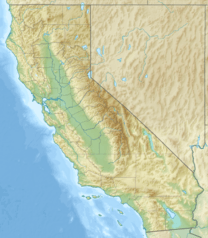Table Mountain (Tuolumne County, California) facts for kids
Quick facts for kids Table Mountain |
|
|---|---|
| Highest point | |
| Elevation | 1,919 ft (585 m) NAVD 88 |
| Geography | |
| Location | Tuolumne County, California, U.S. |
| Parent range | Sierra Nevada |
| Topo map | USGS Tuolumne |
Table Mountain is a unique landform in Tuolumne County, California. It is located close to the town of Jamestown. This mountain is special because it's an inverted valley. This means it's a raised area that used to be a river valley.
Imagine a river flowing through a valley. Long ago, hot lava flowed into this riverbed and filled it up. This lava then cooled and became very hard rock. Over millions of years, the softer ground around this hard rock wore away. But the hard lava rock stayed, creating a winding, raised landform that looks like a mountain.
How Table Mountain Formed
Table Mountain is made of a type of rock called Table Mountain Latite. This rock came from lava that erupted about 10.4 million years ago. The lava flowed from a volcano near where Sonora Pass is today. It followed the path of an ancient river, filling up its valley.
As the Sierra Nevada Mountains slowly rose, the softer dirt and rocks around the lava flow were washed away by rain and wind. The hard lava rock was much stronger and did not erode as easily. This left the lava-filled riverbed standing high above the surrounding land. Even though Table Mountain stretches for many miles, it is usually only a few hundred feet wide.
Some parts of the mountain show interesting rock patterns. Many areas have what are called flow-top breccias. These are rocks made of broken pieces of lava that cooled quickly. Other spots show columnar jointing, which looks like tall, many-sided columns of rock.
Long ago, the lava flow covered gravels that contained gold. Miners found these gold-rich gravels under the lava. People have been mining for gold here since the 1850s.
Plants and Animals
Table Mountain is home to many different plants and animals. In the spring, the top of the mountain is covered with beautiful wildflowers. You can see different types of lupine and the yellow mariposa lily.
After heavy rains in winter and spring, small pools of water form on the flat top. These are called vernal pools. They are important homes for many rare plants and animals. The tough conditions on the mountain top help keep out plants that are not native to the area. This means most of the plants you see here are native species.
You might also spot White-throated swifts. These birds build their nests on the steep rock faces of the mountain.


